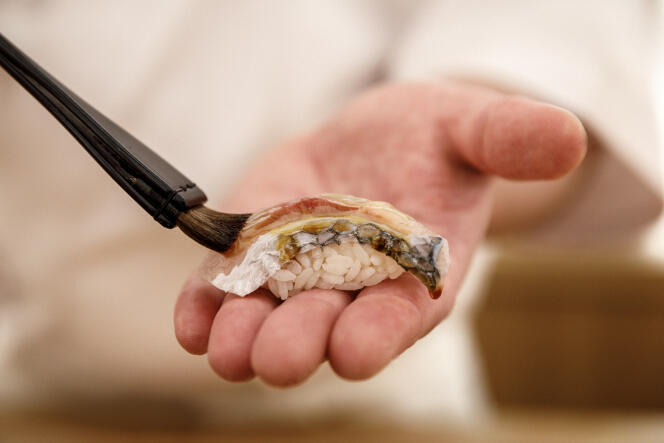In 2022, the French will have eaten 50 million pieces of sushi, according to Gira, a firm specializing in food. Despite the rise in the price of fish, the fever for Japanese dishes has not subsided for around twenty years. France remains the largest consumer in Europe of these dishes based on vinegared rice balls. We have some schools (including The French Sushi Institute), a national competition (organized by the magazine France Sushi) to determine the best artisan, and even global glories (an Angevin, Michaël Pankar, was crowned this year vice-world champion at the Toyosu World Sushi World, the largest fish market on the planet, located in Tokyo).
Gradually, the offer was refined. Of course, fans most often go to small, affordable restaurants where sushi is sometimes served alongside beef and cheese skewers (a pure French invention). But, at the same time, for around ten years, authentic sushiya – a term designating both the cook who prepares the sushi and the establishment – have emerged, mainly in Paris, and their prices have continued to inflate. Menus from 85 euros at Sushi-B, 130 euros at Komatsubaki, 200 euros at Sushi Shunei (with supplement of 75 euros for 15 grams of caviar). And it is likely that the offer will soon break new ceilings in the Cheval Blanc Paris palace, which is to open its own sushi counter with a master of the discipline, Takuya Watanabe.
Is it worth breaking your PEL for a few rice balls? And is there a huge difference between a menu and one ten times more expensive? We asked the question to an expert, Chihiro Masui, culinary author, who notably published Pisces. An art from Japan (Glénat, 2009) and supports French chefs in discovering Japanese flavors. He was first asked to test Sushi Shop (one hundred and twenty-five stores in France). “You want me dead? », laughs the specialist, before accepting the challenge. In the store we approach, the salesman is hardly reassuring. “Are you Japanese?” Sushi Shop has destroyed your gastronomy! »he jokes before taking the order: a small assortment of homemade sushi, enriched with a few creations from chef Mory Sacko (the chain regularly collaborates with gastronomy stars).
The meal, not very copious, costs around twenty euros per person, and it is not the expected disaster. “It’s edible, but it’s not sushi, judges the specialist. I can’t figure out what makes a good sushiya. Rice, for example, which is the most important part – if only in proportion – of sushi, is bad: too compact, mushy, and served cold, when it should be at body temperature. Salmon sushi doesn’t exist in Japan, nor does sacrilegious sweet soy sauce. Their fake wasabi, worked on a horseradish base, really stings too much. In Mory Sacko’s creations, there is a lot, a lot of spice. We can put everything on the rice in theory, but here it totally eclipses the taste of the fish, which is perhaps not a bad thing. »
You have 70% of this article left to read. The rest is reserved for subscribers.
